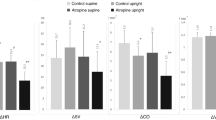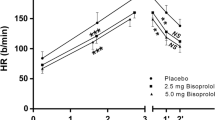Abstract
Objective
Myocardial contractility is regulated by adrenergic stimulation, the strength–length relationship and the force–frequency relationship or Bowditch effect. The latter mechanism was clearly demonstrated in muscle strips, in the isolated heart as well as in in–vivo experiments. The aim of this study was to further investigate the role of the force–frequency effect on the contractile response to exercise or isoproterenol infusion in conditions of restricted increases in heart rate i.e., AV–block, sinus node block and beta–adrenoceptor block.
Methods
Nineteen dogs were instrumented with a left ventricular miniature pressure gauge, catheters in the aorta, pulmonary artery and left atrium and pacing leads on the left atrium and left ventricle. In order to control the chronotropic response during sympathetic stimulation, permanent AV–block was induced in nine dogs, sinus node block using UL–FS 49 and beta–adrenoceptor block using propranolol was studied in ten dogs.
Results
Adrenergic stimulation (isoproterenol 0.4 µg/kg or exercise) after total AV–block failed to increase LVdP/dt. However, increasing LV pacing rate (from 50 up to 200 bpm) prior to adrenergic stimulation elicited a significant increase in LVdP/dt (4762 ± 166 mmHg/s vs. 6485 ± 381 mmHg/s, p < 0.05). In dogs in sinus rhythm, heart rate and LVdP/dt response to isoproterenol and exercise following pre–treatment with UL-FS 49 is significantly reduced, with heart rate increasing from 103 ± 7 up to 154 ± 5 bpm and LV dP/dtmax from 2925 ± 171 mmHg/s to 6249 ± 400 mmHg/s compared to the response in control conditions (HR 220 ± 3 bpm and LV dP/dtmax 7473 ± 616 mmHg/s) (p < 0.05). When heart rate is matched using atrial pacing, the LVdP/dtmax response reached comparable values as observed in control conditions (7310 ± 550 mmHg/s). Similar responses were obtained during exercise. Beta–adrenoceptor blockade attenuates considerably the heart rate and LVdP/dt response to sympathetic stimulation. Adjusting heart rate with atrial pacing restores only partially LVdP/dtmax.
Conclusion
During sympathetic stimulation, the chronotropic response plays a major role for the concomitant full expression of the inotropic response. In conditions where increases in heart rate are absent or severely restricted such as in permanent AV–block, sinus node block and beta–adrenoceptor block, the inotropic response will also be impaired.
Similar content being viewed by others
References
Alpert NR, Leavitt BJ, Itlleman FP, Hasenfuss G, Pieske B, Mulieri LA (1998) A mechanistic analysis of the force-frequency relation in non-failing and progressively failing human myocardium. Basic Res Cardiol (S1) 93:23–32
Bhargava V, Shabetai R, Mathiäsen RA, Dalton N, Hunter JJ, Ross J Jr (1998) Loss of adrenergic control of the force-frequency relation in heart failure secondary to idiopathic or ischemic cardiomyopathy. Am J Cardiol 81:1130–1137
Bowditch HP (1871) Über die Eigenthümlichkeiten der Reizbarkeit, welche die Muskelfaseren des Herzens zeigen. Berichte der Königlich-Sächsischen Gesellschaft der Wissenschaften 23:652–689
Crozatier B (1998) Force-Frequency relations in nonfailing and failing animal myocardium. Basic Res Cardiol (Suppl 1) 93:46–50
Eising GP, Hammond HK, Helmer GA, Gilpin E, Ross J jr (1994) Force-frequency relations during heart failure in pigs. Am J Physiol 267:H2516–H2522
Euler DE (1999) Cardiac alternance: mechanisms and pathophysiological signi fcance. Cardiovasc Res 42:583–590
Freeman GL, Little WC, O’Rourke RA (1987) Influence of heart rate on left ventricular performance in conscious dogs. Circ Res 61:455–464
Goethals M, Raes A, Bogaert van PP (1993) Use-dependent block of the pacemaker current If in rabbit sinoatrial node cells by zatebradine (UL-FS 49). Circulation 88:2389–2401
Guth BD, Heusch G, Seitelberger R, Ross J Jr ( 1987) Mechanism of bene.cial effect of β-adrenergic blockade on exerciseinduced myocardial ischemia. Circ Res 60:738–746
Guth BD, Heusch G, Seitelberger R, Ross J Jr (1987) Elimination of exerciseinduced regional myocardial dysfunction by a bradycardiac agent in dogs with chronic coronary stenosis. Circulation 75:661–669
Hardmann SMC (1994) Clinical implications of the interval-force relationship of the heart. Postgrad. Med J 70:553–557
Hasenfuss G, Holubarsch C, Hermann HP, Astheimer K, Pieske B, Just H (1994) In.uence of the force-frequency relationship on haemodynamics and left ventricular function in patients with non-failing hearts and in patients with dilated cardiomyopathy. Eur Heart J 15:164–170
Heyndrickx GR, Vilaine JP, Knight DR, Vatner SF (1985) Effects of altered site of electrical activation on myocardial performance during inotropic stimulation. Circulation 71:1010–1016
Heyndrickx GR, Vantrimpont P, Present L, Vilaine JP, Leusen I (1985) Inotropic response to isoproterenol is rate dependent in conscious dogs with total atrioventricular block. Circulation 72:III-86
Higginbotham MB, Morris KG, Williams RS, McHale PA, Coleman RE, Cobb FR (1986) Regulation of stroke volume during submaximal and maximal upright exercise in normal man. Circ Res 58:281–291
Higgins CB, Vatner SF, Franklin D, Braunwald E (1973) Extent of regulation of the heart’s contractile state in the conscious dog by alteration in the frequency of contraction. J Clin Invest 52:1189–1194
Ilebekk A, Lekven J, Kiil F (1978) Cardiac performance: independence of adrenergic inotropic and chronotropic effects. Am J Physiol 234:H525–H532
Indolfi C, Guth BD, Miura T, Miyazaki S, Schultz R, Ross J Jr (1989) Mechanisms of improved ischemic regional dysfunction by bradycardia: studies on UL-FS 49 in swine. Circulation 80:983–993
Indolfi C, Ross J Jr (1993) The role of heart rate in myocardial ischemia and infarction : implications of myocardial perfusion- contraction matching. Progr Card Dis 36:61–74
Kambayashi M, Miura T, Oh BH, Rockmann HA, Murata K, Ross J Jr (1992) Enhancement of the force-frequency effect on myocardial contractility by adrenergic stimulation in conscious dogs. Circulation 86:572–580
W, Lillie C (1984) Cardiovascular characterization of UL-FS 49, 1,3,4,5- tetrahydro-7,8-dimethoxy-3-(3-((2-(3,4- dimethoxyphenyl)ethyl)methylimino) propyl)-2H-3-benzazepin-2-ON Hydrochloride, a new “specific bradycardic agent”. Eur J Pharmacol 104:9–18
Koch-Weser J, Blinks JR (1963) The in.uence of the interval between beats on myocardial contractility. Pharmacol Rev 15:601–652
Laperche T, Logaert D, Cohen-Solal A, Gourgon R (1999) Potential interests of heart rate lowering drugs. Heart 81:336–341
Lechat P (1998) Beta-blocker treatment in heart failure. Role of heart rate reduction. Basic Res Cardiol (Suppl 1) V-VI 93:148–155
Lemaire S, Piot C, Leclercq F, Leuranguer V, Nargeot J, Richard S (1998) Heart rate as a determinant of L-type Ca2+ channel activity: Mechanisms and implication in force-frequency relation. Basic Res Cardiol (Suppl 1) 93:51–59
Little WC (1985) The left ventricular dPdtmax-enddiastolic volume relation in closed chest dogs. Circ Res 56:808–815
Mahler F, Ross J Jr, O’Rourke RA, Covell JW (1975) Effects of changes in preload, afterload and inotropic state on ejection and isovolumic phase measures of contractility in the conscious dog. Am J Cardiol 35:626–633
Mahler F, Yoran C, Ross J Jr (1974) Inotropic effects of tachycardia and post stimulation potentiation in the conscious dog. Am J Physiol 227:569–575
Mason D (1969) Usefulness and limitations of the rate of rise of intraventricular pressure (dp/dt) in the evaluation of myocardial contractility in man. Am J Cardiol 23:516–527
Miura T, Miyazaki S, Guth BD, Kambayashi M, Ross J Jr (1992) Influence of the force-frequency relation on left ventricular function during exercise in conscious dogs. Circulation 92:563–571
Mulieri LA, Hasenfuss G, Leavitt B, Allen PD, Alpert NR (1992) Altered force-frequency relation in human heart failure. Circulation 85:1743–1750
Palakodeti V, Oh S, Oh B-H, Mao L, Hongo M, Peterson KL, Ross J Jr (1997) Force-frequency effect is a powerful determinant of myocardial contractility in the mouse. Am J Physiol (Heart Circ Physiol 42) 273:H1283–H1290
Pieske B, Kretschmann B, Meyer M, Holubarsch C, Weirich J, Posival H, Minami K, Just H, Hasenfuss G (1995) Alterations in intracellular calcium handling associated with the inverse forcefrequency relationship in human dilated cardiomyopathy. Circulation 92:1169–1178
Piot C, Lemaire S, Albat B, Seguin J, Nargeot J, Richard S (1996) High frequency- induced upregulation of human cardiac calcium currents. Circulation 93:120–128
Ross J Jr, Miura T, Kambayashi M, Eising GP, Ryu K (1995) Adrenergic control of the force-frequency relation. Circulation 92:2327–2332
Ross J Jr (1998) Adrenergic regulation on the force-frequency effect. Basic Res Cardiol (Suppl I) 93:95–101
Ryu KH, Tanaka N, Dalton N, Mao L, Rockman HA, Milano CA, Ross J Jr (1997) Force-frequency relations in the failing rabbit heart and responses to adrenergic stimulation. J Card Fail 3:27–39
Schaeffer J, Deppert W, Lie RK, Lohff B, Noble MIM (1992) The Interval-Force Relationship of the Heart; Cambridge; Cambridge University Press; 31–39
Schaeffer S, Taylor AL, Lee HR, Niggeman EH, Levine BD, Popma JJ, Mitchell JH, Hillis D (1988) Effect of increasing heart rate on left ventricular performance in patients with normal cardiac function. Am J Cardiol 61:617–620
Van de Werf F, Janssens L, Brzostek T, Mortelmans L, Wackers FJTh, Willems GM, Heidbüchel H, Lesaffre E, Scheys I, Collen D, De Geest H (1993) Short-term effects of early intravenous treatment with a beta-adrenergic agent or a speci.c bradycardiac agent in patients with acute myocardial infarction receiving thrombolytic therapy. J Am Coll Cardiol 22:407–416
Author information
Authors and Affiliations
Corresponding author
Rights and permissions
About this article
Cite this article
De Pauw, M., Vilaine, J. & Heyndrickx, G.R. Role of force – frequency relation during AV–block, sinus node block and betaadrenoceptor block in conscious animals. Basic Res Cardiol 99, 360– 371 (2004). https://doi.org/10.1007/s00395-004-0481-8
Received:
Revised:
Accepted:
Published:
Issue Date:
DOI: https://doi.org/10.1007/s00395-004-0481-8




